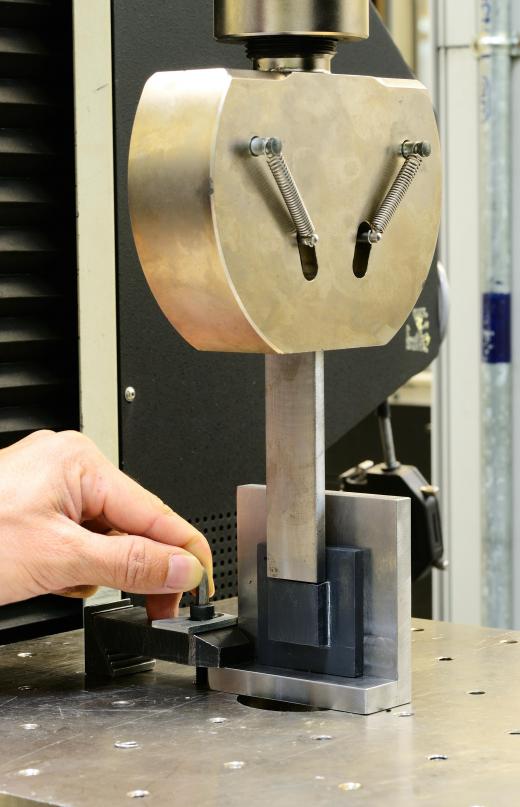What is an Extensometer?
 Mary McMahon
Mary McMahon
An extensometer, sometimes also called a strain gauge, is a device which measures variations in an object's length. These variations can be so minute that they are not identifiable with the naked eye, or significant enough that someone can clearly visualize them. Extensometry, as the practice of measuring such variations is known, is used extensively in materials testing. Tensile testing usually requires an extensometer, and these devices are also used in scientific research, to make and record important observations.
The original extensometer, developed in the 1800s, was a contact extensometer, requiring contact with the material being measured to function. As the material's length fluctuated, it would cause a physical reading to appear on the extensometer. This could be used in stress testing, to find out how much objects and materials deform under strain. However, the need to be in physical contact with the object being measured could also be a problem, as it might skew results or be impractical for certain types of testing.

As a result, noncontact extensometers were developed. These use optical extensomtry, typically with a laser, to measure changes from a distance. Optical extensometry can be very precise and detailed, with the ability to detect minute fluctuations and provide a reading for the person administering a test or experiment. Cost of such systems varies, depending on the objects they are designed to measure and their precision.
Like other devices used to make measurements, an extensometer must be calibrated. Calibration is typically done at the factory where the device is produced as part of the quality control process, ensuring that the device will work ad advertised when it is delivered. People must also periodically recalibrate to confirm that the device is working properly. This can be done in a facility with a calibration kit, or by sending the extensometer out for examination in a lab which specializes in calibration activities.
When not in use, an extensometer needs to be protected to keep it working properly. Many come with protective coverings and cases which can be used to shield the device when it is not in active use. The devices also need to be stored in a way which protects them from shock, as shock and jarring movements can throw the device off, making its readings inaccurate and causing problems for people working with the extensometer. Maintenance and protection of equipment such as extensometers is a collective effort which involves equipment technicians as well as users.
AS FEATURED ON:
AS FEATURED ON:











Discussion Comments
I want to know the procedure for calibration of a strain gauge extensometer. Is it as per ASTM E83? But this specification is for verification and classifying the extensometer grade A, B1 or B2 etc. How to calibrate the existing extensometer.
We are calibrating by using a calibrator and mounting the extensometer on it and then monitor the extensometer reading on computer by increasing the length and checking whether it is matching it or not or what is the error. Is this right?
@irontoenail - That kind of extensometer can be very accurate, but you need to make sure the conditions are absolutely right, particularly when you are measuring very small changes in size.
When you get down that small, even a bit of change in the lighting of the room can make a difference. You also need to make sure the material is being held still and that the video is operating properly.
Not to mention you usually have to attach marks to the material in order to show how much it has moved.
Certain kinds of laser extensometer are much more accurate and easier to use, although they can be more expensive.
Another form of extensometer we learned about in my science class, is one that works with digital video.
It's actually pretty obvious, but can be surprisingly accurate if it is done in the right conditions.
You put the material you want to measure in front of a digital camera and record it in high definition video while it changes in size. This way, you not only get the size it changes to, you also record how long it takes.
By adding these pieces of data to the amount of pressure you put the material under, you can work out a lot of stuff about the properties of the original material.
Post your comments